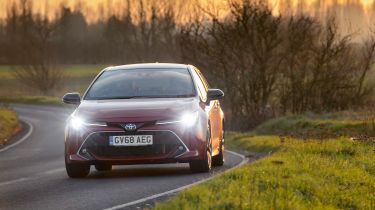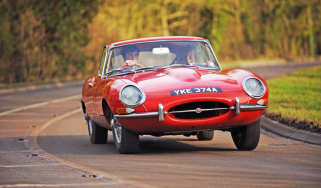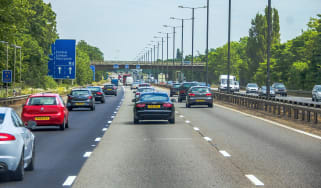Dipped headlights: what are they and when to use them
We explain dipped headlights, when to use them, and the differences between dipped, main, and daytime running lights

Even with the advent of automatic headlights, it’s important for every driver to know what dipped headlights are and how to use them. Cars today have more than just one set of lights; dipped headlights sit alongside full beam headlights, fog lights and daytime running lights.
 What are adaptive and matrix LED headlights?
What are adaptive and matrix LED headlights?
To drive safely in the dark, and to make sure you don’t dazzle oncoming drivers, it’s vital to know when to use each set of lights. Even if your car has an automatic headlight mode, the driver will still be responsible for switching between dipped and main beams, so read on to find out when to use them. We’ve also covered the differences between dipped beam headlights and other lights, and what they should be used for.
What are dipped headlights?
Dipped beam headlights are the default setting for your headlights at night. They provide enough light to illuminate the road ahead in the dark, but they’re angled downward so as not to dazzle oncoming drivers. On the other hand, full beam headlights point forwards and are only to be used when the road ahead is empty.
Most cars also feature sidelights and, since 2011, nearly all cars also have daytime running lights (DRLs), which we'll discuss shortly. To avoid dazzling or blinding other drivers, dipped beam lights need to be pointed below the eye level of other road users, and this is checked as part of a vehicle’s MoT.
According to the Highway Code, you should turn on your sidelights and rear registration plate lights between sunset and sunrise on roads with street lighting and built-up areas. Dipped beam headlights are required on all other roads at night, defined as the period from half an hour before sunset to half an hour after sunrise.
When should I use dipped headlights?
According to The Highway Code, dipped beam headlights should be used at night in built-up areas and during dull daytime weather to ensure you're visible to others. While sidelights are the minimum legal requirement at night in built-up areas, dipped beam headlights are a better option whenever it's dark or visibility is reduced.
When it’s raining hard enough to require the continual use of your wipers, it’s also recommended that you turn on your dipped headlights regardless of whether it’s dark or not. Heavy rain can reduce visibility and obscure you from other drivers – turning on your dipped headlights will allow other drivers to spot you more easily. Headlights should also be used when passing through a long tunnel, and you will often see this signposted as you enter one. If it’s so dark that you can’t see your dashboard’s dials clearly, this is a sign that you should turn your headlights on.
Many modern cars have an ‘auto’ setting for their lights, using sensors to detect when it gets dark and automatically activating the car’s headlights. It’s best practice to keep your lights switched to the ‘auto’ setting rather than keeping the switch in the off position – at least this way the car’s headlights will illuminate when it gets dark. However, there can still be occasions when the driver will have to override this setting manually.
The Highway Code notes that dipped beam headlights should also be used when ‘visibility is seriously reduced’ such as in heavy rain or fog. In these situations, it’s quite possible that your car’s auto lights function will not detect that dipped beam headlights are required, which is why you should always be prepared to manually override the auto function.
In these types of weather events, it’s best practice to avoid using your main beam headlights, as this could actually reduce your visibility. Rain and fog particles in the air can reflect the light from the main beam headlights back at the driver, potentially dazzling them. As the dipped beam headlights point towards the ground, visibility should be improved without any unwanted dazzling.
Of course, you must also use the car’s fog lights when you cannot see for more than 100 metres, but you need to remember to switch them off when visibility increases once again; it’s an offence to drive with fog lights on in good visibility as they may dazzle other road users.
What are daytime running lights (DRLs)?
Daytime running lights (DRLs) are different to dipped and main beam headlights and can cause some confusion. They are permanently illuminated on cars registered since 2011 (and before in some models) and cannot be switched off while the car is running – even if the car’s light switch is in the off position. Crucially, DRLs only illuminate the front lights, so when it becomes dark your rear lights will usually remain unilluminated making your car very hard to see from the rear.
DRLs are only designed to make your car easier to spot during daylight hours, and they won’t provide any illumination of the road ahead, so must never be used instead of headlights once darkness falls.
What are main beam headlights?
Main beam headlights illuminate directly ahead of the driver, unlike dipped beams which are angled downwards. They should only be used when on roads away from built-up areas and only when there are no other vehicles or road users (including pedestrians and cyclists) in front of you, otherwise they will be dazzled.
When your main beam lights are turned on, a blue headlight dashboard symbol will illuminate to remind you that they’re activated. You should turn them down to dipped whenever another vehicle or road user is in sight.
It goes without saying that your lights should be in good condition – check your car regularly to ensure all bulbs illuminate – not just your headlights, but all the lights. The light lenses should also be clean, as dirty lights can seriously reduce their effectiveness.
Dipped beam headlights: a summary
Here are the key points to remember about dipped beam headlights:
- As a minimum, turn on sidelights when it’s dark in built-up areas
- Best practice is to use dipped beam lights at all times when it’s dark
- Use dipped beam lights when ‘visibility is seriously reduced’
- Fog lights can be used when visibility is reduced to less than 100m
- Use your car’s auto light setting but be prepared to switch dipped beam lights on if required
- Daytime running lights are not a substitute for dipped beam headlights
- Only use full-beam headlights if the road ahead is clear of other road users
Read our guide to parking lights and how they work here…
Recommended

Classic car tax exemption: which historic vehicles qualify?
Most Popular
Tips & advice

Car dashboard warning lights: what does each symbol mean?

Electric car charging stations: public networks, charger types, apps and maps









